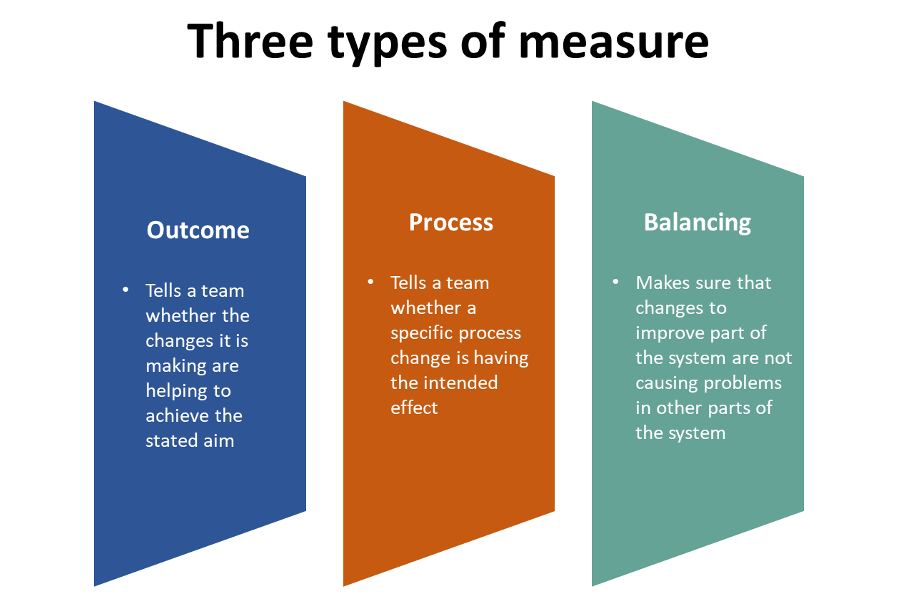Developed by Gerald Langley and colleagues, this model is the preferred framework for improvement work at CNWL. This model works on the basis of five principles of improvement:

This model provides the framework and structure for your improvement work.
Find out more about each part of the Model for Improvement here:
Setting your Aim statement
Introduction to Measurement
PSDA cycles
Question 1 What are we trying to accomplish?
An Improvement Aim is a short statement that describes the goal or objective that a QI project team would like to reach at the end of their project.
Before you can set your aim, you need to think about what you know already:
- What does the data tell you about the way the system is working and performing?
- What do your processes look like – are there gaps or bottle necks?
- Have you used tools like Fishbone or Pareto Charts to explore your system in more detail?

Your Aim provides the starting point for the next stages of your improvement work.
Aims help to get everyone behind the improvement and ensure that they understand what success looks like.
Question 2 How do we know that a change is an improvement?
This question asks us to think about measures to track progress over time.
Improvement is not just about measurement, however, without measurement you will never be able to answer the question!
Important things about measuring for improvement:
- Ask yourself – What do I need to know? Then think about how you might measure it.
- Data helps your learning – collect and explore data as often as you can to inform your next steps.
- Typically we use more than one type of measure to support our work:

Where possible, we present data using graphs or charts and over time. This helps us to see how our system is working – what is normal, and when we might want to find out more about what is going on. The most common way of charting your data over time is with a Run Chart.

Tips for useful and effective measurement for improvement!
- To track improvement, plot data over time wherever possible
- Seek useful not perfection; measures must be relevant and helpful.
- Keep it simple and be careful about not over-doing process measures
- Use sampling if you have large data sets
- Integrate measurement into daily routine wherever possible.
- Use a mix of process, outcome and balancing measures. Remember to gather qualitative as well as quantitative data
- Agree what you mean - define the measure
We introduce you to Run Charts and measurement more generally at our Bitesize training.
Plan Do Study Act cycles allow us to try out new ideas at small scale, managing the risk inherent in trying something new while learning what works and what doesn’t. Over time, we build belief in our change. As we do this we Ramp up our change, and start to get more people involved in this new way of working. When we are sure that this is the right thing to do for our patients and our staff we Implement the change – that is, we make it part of business as usual.
 Common errors with PDSAs:
Common errors with PDSAs:
- Start too big – instead of starting with one patient or one practitioner, teams try to change everything at once. Start small, build belief and then scale up!
- Take too long between the Do and Study sections – otherwise known as getting stuck in do-do (not a good thing!). Make sure you take time to reflect on what has happened shortly after your initial tests. PDSA cycles are designed to allow you to learn and act quickly.
- Forget that test data is not always the same as project data. It can take a while before you start to see the impact of your change on your key measures for success. Sometimes, therefore, you need to collect very local data to support your test. This might be verbal feedback from a practitioner or patient; time taken to complete a task; noting how many people attend a meeting or session. You might only collect this for a short time, but it is really important in telling you if your change is making the difference you need to see short term.
- Don’t record what has happened. PDSAs help you to record and share your learning. Don’t leave the recording of your testing story until the end – you will forget or miss key learning points that might be critical for success. Keep your data up to date and discuss it with your team as you reflect on your latest PDSA cycles and what you might need to try next.
- Change is not embedded as normal practice at the end of the test. If your tests suggest that the change is the right one for your service, you need to make it part of normal practice. The final stages of a PDSA ramp are those steps that take the change and embed it in local policies, procedures, training and practice. This is what we call Implementing the change.